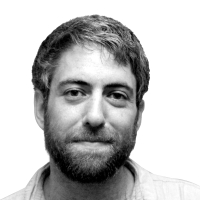AL SHAJAYA, Gaza — Exhausted, battered and traumatized from 50 days of fighting and incessant Israeli bombardment, Gazans are now pouring through the streets lined with the rubble of former buildings and breathing a collective sigh of relief. Whether flocking to reopened cafés or pulling cinder blocks out of their blown-out living rooms, as the ceasefire takes effect people are feeling they have withstood the worst and survived. It's a sentiment Hamas is seizing on to try and claim “victory” in a war that has yet to end the seven-year siege of Gaza – which was supposed to have been its purpose when Hamas was launching rockets at Israel.
Rather than focusing on an agreement that doesn’t seems to get Palestinians anything more than they got at the end of the 2012 war, Hamas changed from its wartime claims that it was fighting a battle to end the blockade to new rhetoric about victory in survival and repelling the Israeli ground invasion.
As darkness fell over Al Shajaya’s ruined buildings and debris-filled craters Wednesday night, hundreds of residents and people from around Gaza climbed on wreckage and filed into living rooms with no front wall in anticipation of the first live public speeches by Hamas's fighting force, the Al Qassam Brigades. The smell of death still lingers in parts of the destroyed neighborhood where tens of thousands have been displaced by Israeli shelling and ground forces.
Masked fighters from all Palestinian factions -- including Palestinian Authority president Mahmoud Abbas’s Fatah movement – clamored over each other to get a place on the podium next to Al Qassam Brigades spokesman Abu Obeida. Fighters displayed shoulder rocket launchers, mortars and assault rifles as the red keffiya-clad Al Qassam representative called for Palestinian unity through armed resistance to Israel and pointed to Al Shajaya as the example of success. It was the scene of a ferocious hit and run campaign against the Israeli forces that cost 16 of them their lives.
“We are not weak,” he boomed through the mike as the stage lights illuminated the grey dust from the demolition that still hangs in the air. “We won the war with our hands,” he claimed about a conflict that has killed over 2000 Palestinians who are mostly civilians -- including 500 children-- wounded more than 10 000, and displaced over 500,000 Gazans, while killing 64 Israeli soldiers and six civilians on the Israeli side of the border.
In the wake of an agreement which has not created free access for Gazan Palestinians to the West Bank, reopened Gaza to the world or even stopped the Israeli drones flying constantly overhead, Hamas’s political and military wings are doing their best to mythologize the battle in Al Shajaya. Even before Al Qassam publicly declared victory last night, Hamas’s political leader in Gaza, Ismail Haniya, was recounting the tale of Al Shajaya to crowds of thousands in Gaza City as he described victory in terms of survival and determined struggle.
While this new narrative might provide some solace for those trying to understand the impact of Israel’s attempt to create a buffer zone in 44 percent of Gaza by razing much of it to the ground, many Gazans are focused on their relief that at last the violence is over.
“Our community has lost our homes, we are just happy the war is finished,” says 62-year-old Wahab Araf Al Wadra, sitting in front of his home, which is missing its front wall. Surrounded by his family under a shrapnel-damaged tin roof, he says he has lived in Al Shajaya all his life. In a somber tone, the balding man with white hair describes having lost two sons in the war, both of them fighters with Fatah. He sees this as a fight Israel waged against the Palestinian people rather than Hamas, but is in the dark on the details of the ceasefire agreement which expands aid and the fishing zone but leaves the issue of prisoners and the blockade to later talks.
In fact, there is very little information available in Gaza about details of the ceasefire agreement, and as people focus on finding a way to rebuild there is uncertainty about the way the terms will affect them.
Standing next to a flattened 11-story Gaza City apartment building where her aunt used to live, 23-year-old Seba Jaafarawi says her main goal is to see the massive pile of rubble rebuilt into another downtown high rise.
“We don’t know if the ceasefire will help us or not,” says Jaafarawi. She is shocked by the breadth of the havoc unleashed on Gaza and is devastated by the price Palestinians have paid. She talked about the way she remembers this place growing up, and about the pain of today. “The picture of Gaza has been changed forever,” she said.





